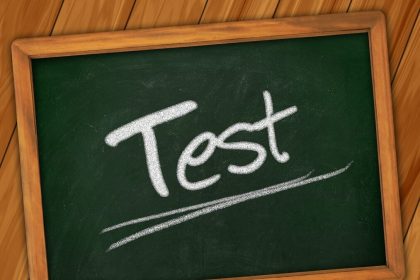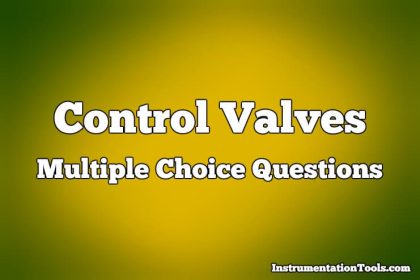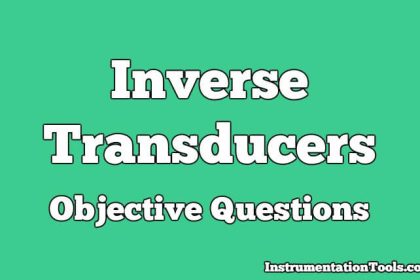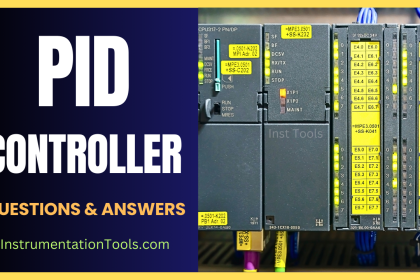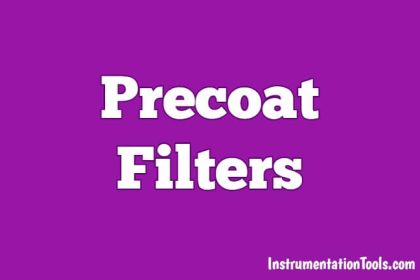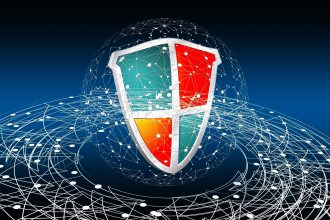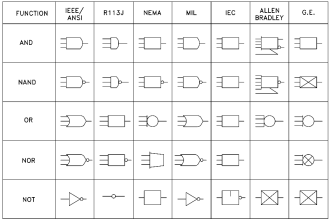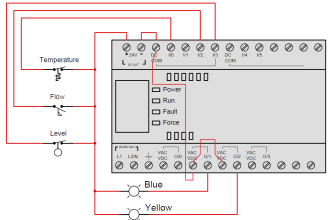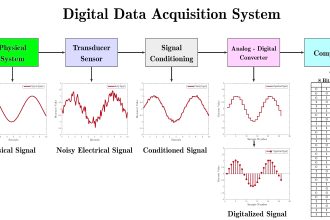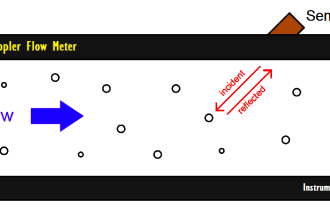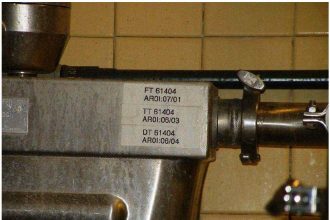Learn the 143 process control terms with our detailed questions and answers glossary to review your technical knowledge.
Process Control Terms
This process control terms video provides the first 50 questions with detailed explanations.
Question 1
What is a Multi-position Controller?
A. A controller with binary output
B. A controller with constant output
C. A controller without sensors input
D. A controller with multiple discrete output values
Show the Answer
A controller with multiple discrete output values
Question 2
What is Cascade Control Action?
A. Control with feedback and feedforward
B. Control where one controller’s input is another’s setpoint
C. Control where one controller’s output is another’s setpoint
D. Control with multiple outputs
Show the Answer
Control where one controller’s output is another’s setpoint
Question 3
What is Ambient Pressure?
A. The pressure at the output
B. The internal device pressure
C. The pressure at the sensing element
D. The pressure of the medium surrounding a device
Show the Answer
The pressure of the medium surrounding a device
Question 4
What is Hysteresis?
A. Difference between maximum and minimum output
B. Maximum difference between upscale and downscale values
C. Minimum difference between input and output
D. Error at zero input
Show the Answer
Maximum difference between upscale and downscale values
Question 5
What is a Self-Operated (Regulator) Controller?
A. A controller requiring external power
B. A controller with binary output
C. A controller using energy from the controlled system
D. A feedback-free controller
Show the Answer
A controller using energy from the controlled system
Question 6
What is an Error?
A. The input signal to a controller
B. The rate of change of a variable
C. The desired value of a variable
D. The deviation between measured and true value
Show the Answer
The deviation between measured and true value
Question 7
What is Thermal Shock?
A. Desired temperature setpoint
B. Gradual temperature change
C. Noise in the system
D. Abrupt temperature change
Show the Answer
Abrupt temperature change
Question 8
What is Time Response?
A. The response to a gradual input change
B. The behavior of output over time
C. The time response to an input change
D. The desired setpoint
Show the Answer
The time response to an input change
Question 9
What is Common Mode Interference?
A. Interference between measuring circuit terminals and ground
B. Electrostatic field interference
C. Magnetic field interference
D. Interference between signal terminals
Show the Answer
Interference between measuring circuit terminals and ground
Question 10
What is Reproducibility?
A. Performance during failure
B. Average performance over time
C. Closeness of consecutive measurements over time
D. The ability to maintain a setpoint
Show the Answer
Closeness of consecutive measurements over time
Question 11
What is an Auctioneering Device?
A. A cost analysis tool
B. A selector of extreme signals
C. A device for bidding
D. A data aggregator
Show the Answer
A selector of extreme signals
Question 12
What is Supervisory Control Action?
A. Independent control with intermittent corrections
B. Control with external adjustments
C. Control with no feedback
D. Direct control of all loops
Show the Answer
Independent control with intermittent corrections
Question 13
What is a Transducer?
A. The desired setpoint
B. A device converting one form of energy to another
C. A device converting one form of energy to voltage
D. The stability of the control system
Show the Answer
A device converting one form of energy to another
Question 14
What is a Closed (Feedback Loop) Loop?
A. A signal path with external control
B. A manual control system
C. A signal path including feedback
D. A signal path without feedback
Show the Answer
A signal path including feedback
Question 15
What is Proportional Gain?
A. Minimum gain of a system
B. Gain with integral control
C. Ratio of output change to input change
D. Gain with feedback
Show the Answer
Ratio of output change to input change
Question 16
What is a Reverse-Acting Controller?
A. A controller where output decreases with input
B. A feedback-free controller
C. A controller with binary output
D. A controller with constant output
Show the Answer
A controller where output decreases with input
Question 17
What is Static Gain?
A. Gain without feedback
B. Gain at zero frequency
C. Gain with constant input
D. Gain with feedback
Show the Answer
Gain at zero frequency
Question 18
What is Ramp Response Time?
A. The stability of the control system
B. The time of response to input change
C. The desired setpoint
D. The time interval by which an output lags an input
Show the Answer
The time interval by which an output lags an input
Question 19
What is a Controlling System?
A. A system with fixed output
B. A system with no feedback
C. A system for manual adjustments
D. A system for deliberate manipulation of variables
Show the Answer
A system for deliberate manipulation of variables
Question 20
What is Derivative (Rate) Control Action?
A. Control based on cumulative error
B. Control based on current error
C. Control based on rate of change of error
D. Control based on absolute value
Show the Answer
Control based on rate of change of error
Question 21
What is Integral (Reset) Control Action?
A. Control ignoring past errors
B. Control based on current error
C. Control predicting future error
D. Control based on cumulative error
Show the Answer
Control based on cumulative error
Question 22
What is Load Impedance?
A. Impedance presented by the source
B. Impedance presented to the output
C. Impedance of the signal
D. Impedance of the input device
Show the Answer
Impedance presented to the output
Question 23
What is Zero Error?
A. Error at any point
B. Error due to drift
C. Error at the upper range value
D. Error at the zero point
Show the Answer
Error at the zero point
Question 24
What is a Transmitter?
A. The desired setpoint
B. A device converting signals
C. A transducer responding to a measured variable
D. A device receiving signals
Show the Answer
A transducer responding to a measured variable
Question 25
What is System Deviation?
A. Setpoint change
B. Instantaneous value minus setpoint
C. Desired value
D. Constant output range
Show the Answer
Instantaneous value minus setpoint
Question 26
What is Noise?
A. Unwanted signal component
B. The desired signal component
C. The speed of response
D. The stability of the control system
Show the Answer
Unwanted signal component
Question 27
What is Repeatability?
A. Performance during failure
B. Closeness of consecutive measurements under the same conditions
C. Average performance over time
D. The ability to maintain a setpoint
Show the Answer
Closeness of consecutive measurements under the same conditions
Question 28
What is the Time Constant?
A. The value T in an exponential response term
B. The stability of the control system
C. The time of response to input change
D. The desired setpoint
Show the Answer
The value T in an exponential response term
Question 29
What is Feedforward Control Action?
A. Control based on predicted disturbances
B. Control based on feedback
C. Control based on average values
D. Control with no adjustments
Show the Answer
Control based on predicted disturbances
Question 30
What is a Primary Element?
A. The system element converting measured variable energy
B. The desired setpoint
C. The final controlling element
D. The element providing feedback
Show the Answer
The system element converting measured variable energy
Question 31
What is a Frequency Response Characteristic?
A. A graph of flow rate changes
B. A plot of temperature vs. time
C. Relationship between input and output frequencies
D. A plot of amplitude and phase vs. frequency
Show the Answer
A plot of amplitude and phase vs. frequency
Question 32
What is an Indirectly-Controlled Variable?
A. A variable whose value is sensed to originate a feedback signal
B. The desired setpoint
C. A variable not originating a feedback signal but influenced by another
D. Noise in the system
Show the Answer
A variable not originating a feedback signal but influenced by another
Question 33
What is a Signal?
A. The desired setpoint
B. Information about a variable
C. The stability of the control system
D. Noise in the system
Show the Answer
Information about a variable
Question 34
What is a Setpoint (Command)?
A. The actual value of the controlled variable
B. The desired value of the controlled variable
C. The speed of response
D. The deviation from the desired value
Show the Answer
The desired value of the controlled variable
Question 35
What is Normal Mode Interference?
A. Common mode interference
B. Magnetic field interference
C. Interference between measuring circuit terminals
D. Electrostatic field interference
Show the Answer
Interference between measuring circuit terminals
Question 36
What is an Input Signal?
A. The actual value of the controlled variable
B. The desired setpoint
C. The signal applied to a device
D. The deviation from the desired value
Show the Answer
The signal applied to a device
Question 37
What is Shared Time Control Action?
A. Control based on time intervals
B. Control action divided among multiple loops
C. Control with constant monitoring
D. Control with no specific schedule
Show the Answer
Control action divided among multiple loops
Question 38
What is Deviation?
A. Maintaining setpoint
B. Constant output range
C. Any departure from desired value
D. No change in input
Show the Answer
Any departure from desired value
Question 39
What is Modulation?
A. The process of varying one wave characteristic by another
B. The speed of response
C. The stability of the control system
D. Maintaining a fixed signal
Show the Answer
The process of varying one wave characteristic by another
Question 40
What is Span?
A. Noise in the system
B. The stability of the control system
C. The desired setpoint
D. The algebraic difference between the upper and lower range-values
Show the Answer
The algebraic difference between the upper and lower range-values
Question 41
What is Step Response?
A. The time response to an instantaneous input change
B. The desired setpoint
C. The behavior of output over time
D. The response to a gradual input change
Show the Answer
The time response to an instantaneous input change
Question 42
What is Zero Elevation?
A. The shift of zero above the lower range value
B. The value of zero at the lower range limit
C. The stability of the control system
D. The stability of the control system
Show the Answer
The shift of zero above the lower range value
Question 43
What is a Direct–Acting Controller?
A. A controller with constant output
B. A controller with random output
C. A controller where output increases with input
D. A controller with no feedback
Show the Answer
A controller where output increases with input
Question 44
What is a Feedback Signal?
A. Noise in the system
B. The deviation from the desired value
C. The return signal from a measurement
D. The desired setpoint
Show the Answer
The return signal from a measurement
Question 45
What are Normal Operating Conditions?
A. Range of conditions for normal operation
B. Conditions during device failure
C. The speed of response
D. The desired setpoint
Show the Answer
Range of conditions for normal operation
Question 46
What is Rise Time?
A. The stability of the control system
B. The desired setpoint
C. The time required for output to change from a specified percentage of the steady-state increment
D. The time of response to input change
Show the Answer
The time required for output to change from a specified percentage of the steady-state increment
Question 47
What is a Directly-Controlled System?
A. A system with manual adjustments
B. The desired setpoint
C. The system directly guided by the final controlling element
D. A feedback-free system
Show the Answer
The system directly guided by the final controlling element
Question 48
What is Signal Output?
A. Noise in the system
B. The desired setpoint
C. The deviation from the desired value
D. The signal delivered by a device
Show the Answer
The signal delivered by a device
Question 49
What is a Summing Point?
A. The point where signals are added algebraically
B. The desired setpoint
C. The deviation from the desired value
D. Noise in the system
Show the Answer
The point where signals are added algebraically
Question 50
What is a Multi-Element (Multi-Variable) Control System?
A. A system using multiple process variables
B. A fixed-variable system
C. A single-loop control system
D. A system with one input
Show the Answer
A system using multiple process variables
Process Control Glossary
This process control glossary video provides the next 50 questions with detailed explanations.
Question 51
What is a Proportional Plus Integral (Reset) (PI) Controller?
A. A controller with derivative action only
B. A controller combining proportional and integral actions
C. A controller with constant output
D. A controller with no integral action
Show the Answer
A controller combining proportional and integral actions
Question 52
What is Load Regulation?
A. The change in output from no-load to full-load
B. The speed of response
C. The ability to maintain a setpoint
D. The stability of the control system
Show the Answer
The change in output from no-load to full-load
Question 53
What is Reference Performance?
A. Average performance over time
B. Performance during failure
C. Performance under varying conditions
D. Performance under reference conditions
Show the Answer
Performance under reference conditions
Question 54
What is Step Response Time?
A. The stability of the control system
B. The time of response to input change
C. The time required for an output to change from an initial value to a large specified percentage of the final steady-state value
D. The desired setpoint
Show the Answer
The time required for an output to change from an initial value to a large specified percentage of the final steady-state value
Question 55
What is Dead Time?
A. The interval between input change and response
B. The time of response to input change
C. The stability of the control system
D. The desired setpoint
Show the Answer
The interval between input change and response
Question 56
What is the Sampling Period?
A. The speed of response
B. The desired setpoint
C. The continuous observation interval
D. The time interval between observations
Show the Answer
The time interval between observations
Question 57
What is the Suppressed-Zero Range?
A. A fixed value range
B. A range with zero below the lower range-value
C. A range with zero at the midpoint
D. A range with zero at the upper limit
Show the Answer
A range with zero below the lower range-value
Question 58
What is Integral Action Rate (Reset Rate)?
A. Speed of proportional response
B. Rate of change of the output signal
C. Rate of change of the input signal
D. Ratio of integral response to proportional response
Show the Answer
Ratio of integral response to proportional response
Question 59
What is Offset?
A. The desired setpoint
B. The steady-state deviation from setpoint
C. The speed of response
D. The stability of the control system
Show the Answer
The steady-state deviation from setpoint
Question 60
What is a Signal Transducer (Signal Converter)?
A. A device converting one form of energy to another
B. The desired setpoint
C. Noise in the system
D. The deviation from the desired value
Show the Answer
A device converting one form of energy to another
Question 61
What is a Lower Range-Limit?
A. The lowest quantity measurable
B. The desired setpoint
C. The midpoint of the range
D. The highest quantity measurable
Show the Answer
The lowest quantity measurable
Question 62
What is a Manipulated Variable?
A. A fixed characteristic of the system
B. Noise in the system
C. The desired setpoint
D. A quantity varied to change the controlled variable
Show the Answer
A quantity varied to change the controlled variable
Question 63
What is Loop Gain?
A. Minimum gain of a system
B. Gain with constant input
C. Ratio of output to error signal
D. Gain of the open loop
Show the Answer
Ratio of output to error signal
Question 64
What is Control Mode?
A. A random control method
B. A fixed control output
C. A specific control strategy
D. A feedback-free control
Show the Answer
A specific control strategy
Question 65
What is Electrical Interference?
A. Desired signal component
B. Stable output signal
C. External voltage or current affecting circuits
D. Internal noise of a device
Show the Answer
External voltage or current affecting circuits
Question 66
What is a Controller?
A. A manual adjustment tool
B. An automatic device regulating a variable
C. A feedback-free device
D. A fixed-output device
Show the Answer
An automatic device regulating a variable
Question 67
What is an Indirectly-Controlled System?
A. The portion of the system influenced by the directly controlled variable
B. A feedback-free system
C. The desired setpoint
D. A system with manual adjustments
Show the Answer
The portion of the system influenced by the directly controlled variable
Question 68
What is Indicator Travel?
A. Movement of the control element
B. Length of the path described by the indicator
C. Distance of the output signal
D. Distance between input and output
Show the Answer
Length of the path described by the indicator
Question 69
What is Relative Damping?
A. Damping with no feedback
B. Absolute damping value
C. Fixed damping ratio
D. Number expressing quotient of actual to critical damping
Show the Answer
Number expressing quotient of actual to critical damping
Question 70
What is Drift?
A. Change in output-input relationship over time
B. Stable output over time
C. Sudden output change
D. Constant input
Show the Answer
Change in output-input relationship over time
Question 71
What is a Dead Zone?
A. The stability of the control system
B. The range through which an input change causes no response
C. The range with maximum response
D. The desired setpoint
Show the Answer
The range through which an input change causes no response
Question 72
What is Closed Loop Gain?
A. Maximum gain of a system
B. Gain with feedback
C. Minimum gain of a system
D. Gain without feedback
Show the Answer
Gain with feedback
Question 73
What is Power Consumption?
A. The energy used by a device under steady-state conditions
B. The speed of response
C. The maximum voltage of a device
D. The desired setpoint
Show the Answer
The energy used by a device under steady-state conditions
Question 74
What is a Final Controlling Element?
A. Initial sensing device
B. Intermediate control component
C. Feedback element
D. Directly changes manipulated variable
Show the Answer
Directly changes manipulated variable
Question 75
What is Process Pressure?
A. The pressure of the process medium at the sensing element
B. The internal device pressure
C. The desired setpoint pressure
D. The pressure at the output
Show the Answer
The pressure of the process medium at the sensing element
Question 76
What is Zero Suppression?
A. The shift of zero below the lower range value
B. The value of zero at the lower range limit
C. A constant zero value
D. The shift of zero above the lower range value
Show the Answer
The shift of zero below the lower range value
Question 77
What is Resolution?
A. The degree to which equal values can be discriminated
B. The desired setpoint
C. The stability of the control system
D. The speed of response
Show the Answer
The degree to which equal values can be discriminated
Question 78
What is an Open Loop?
A. A signal path with external control
B. A signal path without feedback
C. A signal path with feedback
D. A manual control system
Show the Answer
A signal path without feedback
Question 79
What is Electrostatic Field Interference?
A. Interference from magnetic fields
B. Interference induced by electrostatic fields
C. Internal noise
D. Stable output signal
Show the Answer
Interference induced by electrostatic fields
Question 80
What is a Reference-Input Signal?
A. Noise in the system
B. The external standard for comparison
C. The desired setpoint
D. The deviation from the desired value
Show the Answer
The external standard for comparison
Question 81
What is a Proportional Plus Derivative (Rate) (PD) Controller?
A. A controller combining proportional and rate actions
B. A controller with constant output
C. A controller with integral action only
D. A controller with no derivative action
Show the Answer
A controller combining proportional and rate actions
Question 82
What is Adaptive Control Action?
A. Automatic adjustment of control parameters
B. Time-based control changes
C. Fixed control parameters
D. Manual control adjustments
Show the Answer
Automatic adjustment of control parameters
Question 83
What is Magnetic Field Interference?
A. Stable output signal
B. Internal noise
C. Electrostatic field interference
D. Interference from magnetic fields
Show the Answer
Interference from magnetic fields
Question 84
What is Differential Mode Interference?
A. Magnetic field interference
B. Electrostatic field interference
C. Interference between measuring circuit terminals
D. Interference between circuit terminals and ground
Show the Answer
Interference between measuring circuit terminals
Question 85
What is a Directly Controlled Variable?
A. The desired setpoint
B. A variable influenced by another variable
C. A variable whose value is sensed to originate a feedback signal
D. Noise in the system
Show the Answer
A variable whose value is sensed to originate a feedback signal
Question 86
What is Proportional Control Action?
A. Continuous linear control action
B. Non-linear control action
C. Random control action
D. Discrete control action
Show the Answer
Continuous linear control action
Question 87
What is a Return Signal?
A. The deviation from the desired value
B. The desired setpoint
C. Noise in the system
D. The signal from the output to the input
Show the Answer
The signal from the output to the input
Question 88
What is a Ratio Controller?
A. A controller with no feedback
B. A controller with constant output
C. A controller with binary output
D. A controller maintaining a fixed ratio
Show the Answer
A controller maintaining a fixed ratio
Question 89
What is a Time Proportioning Controller?
A. A controller with binary output
B. A feedback-free controller
C. A controller using periodic pulses
D. A controller with continuous output
Show the Answer
A controller using periodic pulses
Question 90
What is Pressure Supply?
A. The internal device pressure
B. The desired setpoint pressure
C. The pressure at the supply port of the device
D. The pressure at the output
Show the Answer
The pressure at the supply port of the device
Question 91
What is Transverse Interference?
A. Internal noise
B. Interference between measuring circuit terminals
C. Interference from longitudinal fields
D. Interference between circuit terminals and ground
Show the Answer
Interference between measuring circuit terminals
Question 92
What is Proportional Plus Derivative (Rate) Control Action?
A. Control based on constant value
B. Control based on cumulative error
C. Control predicting future error
D. Control with no integral action
Show the Answer
Control predicting future error
Question 93
What is an Integral (Reset) (I) Controller?
A. A controller with constant output
B. A controller with no integral action
C. A controller with derivative action only
D. A controller producing integral control action only
Show the Answer
A controller producing integral control action only
Question 94
What is a Sampling Controller?
A. A controller with binary output
B. A feedback-free controller
C. A controller using intermittent signal observations
D. A controller with continuous monitoring
Show the Answer
A controller using intermittent signal observations
Question 95
What is Ambient Temperature?
A. Noise in the system
B. The temperature of the medium surrounding a device
C. The internal temperature of a device
D. The desired setpoint
Show the Answer
The temperature of the medium surrounding a device
Question 96
What is a Measured Signal?
A. The deviation from the desired value
B. The desired setpoint
C. Noise in the system
D. The signal representing the measured variable
Show the Answer
The signal representing the measured variable
Question 97
What is Overrange?
A. Range above upper limit
B. Range within specified limits
C. Desired range of operation
D. Range below lower limit
Show the Answer
Range above upper limit
Question 98
What is Proportional Plus Integral (Reset) Control Action?
A. Control based on current and past errors
B. Control with constant output
C. Control ignoring past errors
D. Control predicting future error
Show the Answer
Control based on current and past errors
Question 99
What is Settling Time?
A. The time required for the output to stabilize within a specified band
B. The time of response to input change
C. The stability of the control system
D. The desired setpoint
Show the Answer
The time required for the output to stabilize within a specified band
Question 100
What is the Mounting Position?
A. The internal layout of a device
B. The stability of the control system
C. The position of a device relative to surroundings
D. The speed of response
Show the Answer
The position of a device relative to surroundings
Process Control Terminology
This process control terminology video provides you the detailed explanations for the remaining questions.
https://www.youtube.com/watch?v=pU8w59BKIyo&list=PLI78ZBihrkE3r0spCEdNIGmbaEfKPqUSa&index=46
Question 101
What is Linearity?
A. The speed of response
B. The ability to maintain a fixed value
C. Closeness to a straight line
D. The stability of output
Show the Answer
Closeness to a straight line
Question 102
What is the Signal to Noise Ratio?
A. The deviation from the desired value
B. Noise in the system
C. The desired setpoint
D. The ratio of signal amplitude to noise amplitude
Show the Answer
The ratio of signal amplitude to noise amplitude
Question 103
What is Reference Accuracy?
A. Accuracy in normal conditions
B. Highest possible accuracy
C. Accuracy at a reference point
D. Average accuracy over time
Show the Answer
Accuracy at a reference point
Question 104
What are Operative Limits?
A. Range of conditions without impairment
B. The speed of response
C. Conditions for device failure
D. The desired setpoint
Show the Answer
Range of conditions without impairment
Question 105
What is a Span Error?
A. Error at the lower range value
B. Error at the midpoint
C. Error across the entire range
D. Error in the feedback signal
Show the Answer
Error across the entire range
Question 106
What is Sensitivity?
A. The stability of the control system
B. The speed of response
C. The desired setpoint
D. The ratio of output change to input change
Show the Answer
The ratio of output change to input change
Question 107
What is a Bode Diagram?
A. A temperature vs. frequency plot
B. A log-log plot of amplitude and phase
C. A plot of pressure vs. time
D. A flow rate vs. volume plot
Show the Answer
A log-log plot of amplitude and phase
Question 108
What is a Proportional (P) Controller?
A. A feedback-free controller
B. A controller with binary output
C. A controller producing proportional control action only
D. A controller with integral action
Show the Answer
A controller producing proportional control action only
Question 109
What is Accuracy?
A. Speed of response
B. Closeness to true value
C. Range of operation
D. Stability over time
Show the Answer
Closeness to true value
Question 110
What is Proportional Plus Integral (Reset) Plus Derivative (Rate) Control Action?
A. Control with no proportional action
B. Combined control based on error and its rate of change
C. Control ignoring future error
D. Control with constant output
Show the Answer
Combined control based on error and its rate of change
Question 111
What is an Error Signal?
A. The actual value of the controlled variable
B. The deviation between setpoint and feedback signal
C. The desired setpoint
D. Noise in the system
Show the Answer
The deviation between setpoint and feedback signal
Question 112
What is Dynamic Response?
A. The behavior of output over time
B. The speed of response
C. The stability of the control system
D. The desired setpoint
Show the Answer
The behavior of output over time
Question 113
What is a Proportional Plus Integral (Reset) Plus Derivative (Rate) (PID) Controller?
A. A controller combining P, I, and D actions
B. A controller with no proportional action
C. A controller with binary output
D. A controller with constant output
Show the Answer
A controller combining P, I, and D actions
Question 114
What is the Warm-Up Period?
A. The time required for system cooling
B. The time required after energizing a device before rated performance
C. The desired setpoint
D. The stability of the control system
Show the Answer
The time required after energizing a device before rated performance
Question 115
What is Process Temperature?
A. The desired setpoint
B. The internal temperature of a device
C. The temperature of the process medium at the sensing element
D. Noise in the system
Show the Answer
The temperature of the process medium at the sensing element
Question 116
What is High Limiting Control Action?
A. Limiting to an average value
B. Limiting to a maximum value
C. No limitation control
D. Limiting to a minimum value
Show the Answer
Limiting to a maximum value
Question 117
What is a Control System?
A. A system without setpoints
B. A system for deliberate manipulation of variables
C. A manual adjustment system
D. A feedback-free system
Show the Answer
A system for deliberate manipulation of variables
Question 118
What is Low Limiting Control Action?
A. Limiting to an average value
B. Control predicting future values
C. Limiting to a minimum value
D. Control with no lower limit
Show the Answer
Limiting to a minimum value
Question 119
What is Output Impedance?
A. Impedance presented by the output device
B. Impedance of the source
C. Impedance of the signal
D. Impedance of the input device
Show the Answer
Impedance presented by the output device
Question 120
What is a Time Schedule Controller?
A. A controller with constant output
B. A feedback-free controller
C. A controller with binary output
D. A controller adhering to a time schedule
Show the Answer
A controller adhering to a time schedule
Question 121
What is a Process?
A. A manual adjustment system
B. A feedback-free system
C. The collective functions performed in the equipment
D. The desired setpoint
Show the Answer
The collective functions performed in the equipment
Question 122
What is a Parameter?
A. A fixed characteristic of a system
B. A device’s internal setting
C. A constant value
D. A controllable or variable characteristic
Show the Answer
A controllable or variable characteristic
Question 123
What is Upper Range-Limit?
A. The midpoint of the range
B. The desired setpoint
C. The lowest quantity measurable
D. The highest quantity measurable
Show the Answer
The highest quantity measurable
Question 124
What is Range?
A. The region between the limits of measurement
B. The speed of response
C. The desired setpoint
D. The stability of the control system
Show the Answer
The region between the limits of measurement
Question 125
What is Optimizing Control Action?
A. Control with no specific goal
B. Manual adjustment for best value
C. Maintaining a fixed value
D. Automatic seeking of the best value
Show the Answer
Automatic seeking of the best value
Question 126
What are Operating Conditions?
A. Internal factors of a device
B. The speed of response
C. Conditions to which a device is subject
D. The desired setpoint
Show the Answer
Conditions to which a device is subject
Question 127
What is Dynamic Gain?
A. Gain at zero frequency
B. Gain without feedback
C. Gain with constant input
D. Gain for sinusoidal signals
Show the Answer
Gain for sinusoidal signals
Question 128
What is Input Impedance?
A. Impedance of the signal
B. Impedance of the output device
C. Impedance presented to the source
D. Impedance of the load
Show the Answer
Impedance presented to the source
Question 129
What is Direct Digital Control Action?
A. Analog control action
B. Manual control action
C. Control by a digital device
D. Control by mechanical means
Show the Answer
Control by a digital device
Question 130
What is Zero Shift?
A. The stability of the control system
B. A parallel shift of the input-output curve
C. A constant zero value
D. The shift of zero below the lower range value
Show the Answer
A parallel shift of the input-output curve
Question 131
What is Source Impedance?
A. Impedance of the output device
B. Impedance of the signal
C. Impedance presented to the input of a device
D. Impedance presented to the load
Show the Answer
Impedance presented to the input of a device
Question 132
What is an Element?
A. A complete control system
B. A manual control device
C. A fixed-output device
D. A component of a device or system
Show the Answer
A component of a device or system
Question 133
What is Control Action?
A. Changing system parameters
B. Modifying system structure
C. Recording system performance
D. Adjusting output based on input
Show the Answer
Adjusting output based on input
Question 134
What is a Proportional Band?
A. The change in input required for a full range output change
B. A fixed value range
C. The stability of the control system
D. The speed of response
Show the Answer
The change in input required for a full range output change
Question 135
What is Damping?
A. Maintaining a fixed output
B. Increasing system oscillation
C. Suppression of oscillation
D. Random control actions
Show the Answer
Suppression of oscillation
Question 136
What is the Elevated-Zero Range?
A. A range with zero above the lower range-value
B. A fixed value range
C. A range with zero at the midpoint
D. A range with zero at the lower limit
Show the Answer
A range with zero above the lower range-value
Question 137
What is an On-off Controller?
A. A controller with continuous output
B. A binary controller with fully on/off states
C. A controller with proportional output
D. A feedback-free controller
Show the Answer
A binary controller with fully on/off states
Question 138
What is Longitudinal Interference?
A. Electrostatic field interference
B. Interference from transverse fields
C. Interference appearing between circuit terminals
D. Interference appearing between terminals and ground
Show the Answer
Interference appearing between terminals and ground
Question 139
What is Feedback Control Action?
A. Control without monitoring
B. Control based on output comparison
C. Control by trial and error
D. Control based on preset conditions
Show the Answer
Control based on output comparison
Question 140
What is a Non-Interacting Control System?
A. A system with manual controls
B. A system avoiding disturbance to other variables
C. A system with feedback
D. A system without feedback
Show the Answer
A system avoiding disturbance to other variables
Question 141
What is Ramp Response?
A. The behavior of output over time
B. The total time response to a change in input rate
C. The desired setpoint
D. The response to a sudden input change
Show the Answer
The total time response to a change in input rate
Question 142
What is Dead Band?
A. Constant output range
B. Minimum input range
C. Range with no response
D. Maximum output range
Show the Answer
Range with no response
Question 143
What is a Sensing Element?
A. Feedback element
B. Final controlling device
C. Intermediate control component
D. Directly responsive to measured quantity
Show the Answer
Directly responsive to measured quantity
Read Next:
- Electrical Engineers Objective Questions and Answers
- Industrial Electronics Objective Questions and Answers
- Digital Circuits Objective Questions and Answers
- Electrical Measurement Objective Questions and Answers
- Electronic Circuits Objective Questions and Answers
